Columns
New: REGIONAL REPORT: Who's "against change"?
Or does that just mean some of us are against the sort of change that the powers that be are pushing?
Like 48 hills editor Tim Redmond, I welcome UC Berkeley geographer Dick Walker’s piece in the East Bay Express debunking the supply-side approach to the Bay Area’s affordable housing crisis. As Walker writes, that’s the approach taken by “mainstream policy shops and planners such as Gabriel Metcalf, president and CEO of the pro-urban growth organization SPUR.” In their view, the problem is “activists and neighborhood residents who oppose more market-rate housing devel opment. Their solution is to allow developers to build more freely.”
 Is the real issue in the housing wars growth? How much can one region take? Photo by Peter Menchini
Is the real issue in the housing wars growth? How much can one region take? Photo by Peter Menchini
Walker agrees that the region needs more housing. But “building more housing,” he contends,
cannot solve the problem as long as demand is out of control, as it is today….Three basic forces are driving the Bay Area’s housing prices upward: growth, affluence, and inequality. Three other things make matters worse: finance, business cycles, and geography. All of these operate on the demand side of the equation, and demand is the key to the runaway housing market.
He goes on to mark the region’s 500,000 new jobs since 2010, the tech industry’s huge profits and correspondingly high salaries and wages; the gaping, growing inequality of income and—even worse—of wealth in the Bay Area; and the “geography of privilege and power” that enables “the nouveaux riches of the tech world….to outbid working stiffs, families, artists and the poor” for housing.
Also well-advised are Walker’s recommendations for local policy: restrict speculation via development fees and controls on rents and evictions; create and fund housing land trusts; build new housing that includes low-income units; and do it all in behalf of “a livable city” that incorporates “good design, historic preservation, neighborhood protections, mixed use, and social diversity”—and “a collective, democratic and yes, conflictual process of politics and public debate.”
It’s a commendable agenda, though I wish Walker had grappled with what he rightfully identifies as the “key to the runaway housing market”: inordinate demand, which is to say, excessive growth. Instead his piece raps those who “oppos[e] all new building, greater density, and neighborhood change” and “cling to the idea that our town or neighborhood will remain the same in a dynamic urban system.”
I’ve never met anyone who opposes “all new building, greater density and neighborhood change,” and I’d wager that nobody else has, either. It’s a fiction, part of the diversionary rhetoric employed by none other than Metcalf and Co. that aims to discredit and stigmatize “activists and neighborhood residents who oppose more market-rate development” as irrational extremists.
When people say, “You’re against change,” they really mean, “You’re against the kind of change I want.” The essential question is, what kind of change is that?
As Calvin Welch pointed out in 48hills.org last December, the kind sought by the fast growthers—SPUR, the Bay Area Council, the Building Industry Association, the real estate Democrats, and their allies in the planning profession and the regional planning agencies—is the same kind their ilk purveyed as “urban renewal”: “market capitalism using state power” to achieve “demolition and displacement for tens of thousands of San Franciscans” in the name of “‘housing opportunity.’”
This is the true irrational extremism. And as Welch also points out, in San Francisco urban renewal was defeated by grass-roots activists—
seniors, working-class retirees and Latinos in South of Market and the Mission [who] rejected redevelopment’s market-rate housing and devised the city’s first community-based and community-controlled housing development corporations that built affordable housing owned by the community, keeping thousands of low-income residents in the city.
Today community activists around the Bay Area are fighting against the new urban renewal, a.k.a. “smart growth.” They’re pushing back—not just in San Francisco, but in Alameda, Berkeley, Oakland, Mill Valley, and Palo Alto, among other places.
You read that right: Palo Alto. Thanks to the “nouveaux riches” of the tech world,” Palo Alto has a jobs-to-housing ratio of 3-to-1 and commercial space that’s been so extensively colonized by tech offices that the council passed a citywide ground floor retail space protection ordinance. Should Palo Alto build housing to accommodate all the workers in the city’s tech’s offices? I don’t think so, but I’m not sure what Walker thinks.
His embrace of “high-rises” is incautious. Massive high-density development does not necessarily provide “moderate priced homes” or “low-income public housing.” As ever, the devil is in the details. Witness the controversial 18-story residential project proposed for 2211 Harold Way in downtown Berkeley, the town in which Walker and I both live. It has no affordable units at all—one of many deficiencies cited in a lawsuit filed by a community activist.
Density’s dubious relationship to housing affordability aside, the larger growth question remains. To paraphrase the title of a much-cited article by David Talbot, how many people can one region take? That question would seem to be entailed by Walker’s recognition that demand is “out of control.” It’s suppressed in the halls of power, including the offices of the Association of Bay Area Governments and the Metropolitan Transportation Commission. For the sake of genuinely livable cities, community activists need to raise it, loud and clear.
Zelda Bronstein formerly wrote the Planet's local Public Eye column. She is a former chair of the Berkeley Planning Commission. This article originally appeared on 48hills.org.






